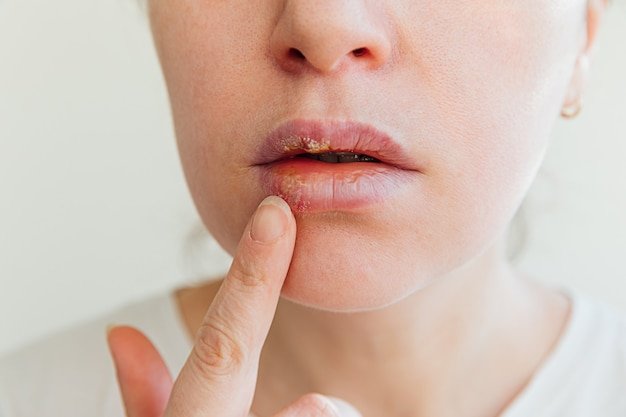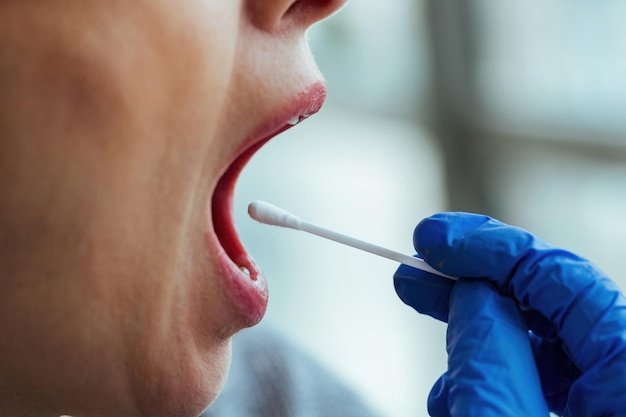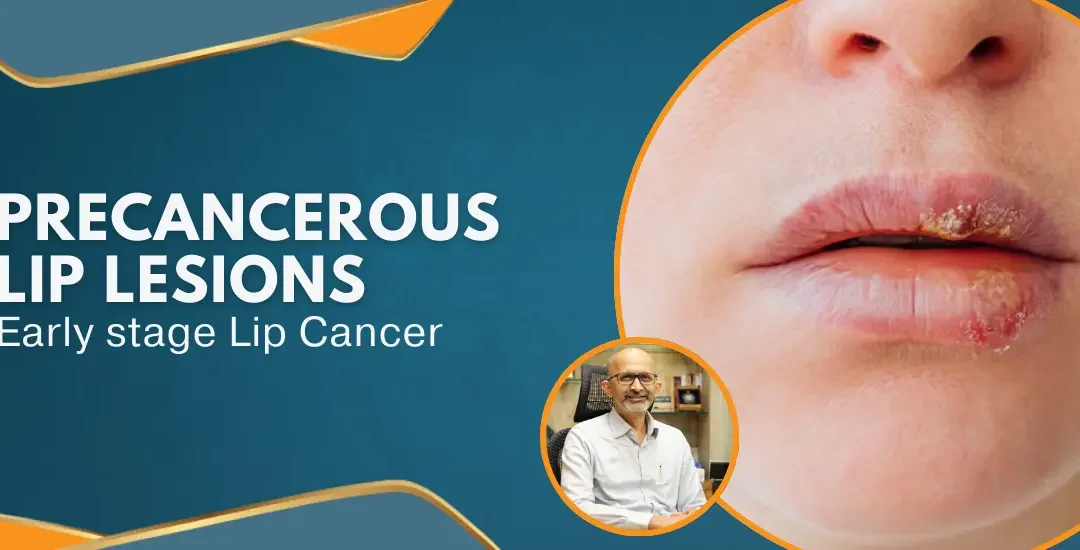Lip cancer refers to the abnormal growth of cells in the lips, leading to the formation of cancerous tumors. It is a type of oral cancer that primarily affects the upper or lower lip. Lip cancer can occur in various forms, with the most common being squamous cell carcinoma. Other types include basal cell carcinoma, adenocarcinoma, and melanoma.
Lip cancer, particularly in its early stages, can present as precancerous lesions that demand attention and prompt intervention. Recognizing and understanding these precancerous conditions is crucial for timely diagnosis and effective management.
“Recognizing precancerous lesions in the lips is a proactive step towards preventing the progression of lip cancer,” says one of the renowned surgical oncologists in India, Dr. Sandeep Nayak. “By identifying and addressing these early warning signs, individuals can take control of their health and seek appropriate medical guidance. “
This blog explores the various aspects of lip cancer, including its risk factors, symptoms, diagnostic methods, and treatment options.
Understanding Precancerous Lip Lesions
Precancerous conditions indicate abnormal cell changes that can potentially progress into cancer if left untreated, posing a higher risk to the individual’s health.
Two common precancerous conditions are:
Leukoplakia:
Leukoplakia is the development of thick, white patches on the mouth’s mucous membranes, potentially caused by chronic irritation from factors like tobacco or alcohol use. Although most cases are benign, some patches can indicate an increased risk of oral cancer.

Actinic cheilitis:
Actinic cheilitis is a condition characterized by dry, scaly, or cracked lips, primarily caused by prolonged sun exposure. It typically affects the lower lip and can result in redness, swelling, and roughness of the lip surface.
If you or a loved one has noticed the symptoms mentioned above, please consult with an experienced oncologist like Dr. Sandeep Nayak at the earliest. Early detection and prompt treatment are crucial for successfully managing lip cancer.
Risk Factors of Precancerous Lip Lesions
Various factors can increase the risk of developing precancerous lip lesions, including:
- Excessive Sun Exposure: Prolonged and unprotected exposure to ultraviolet (UV) radiation from the sun is a significant risk factor for developing precancerous lip conditions. The lips are particularly vulnerable to UV damage, making sun protection crucial.
- Tobacco Use: Both smoking and smokeless tobacco products are known to increase the risk of developing precancerous lip lesions. The chemicals in tobacco can irritate and damage the lip tissues, leading to abnormal cell changes.
- Alcohol Consumption: Excessive alcohol consumption is associated with a higher risk of developing precancerous conditions in the lips. Alcohol can damage the lip tissues and weaken the body’s ability to repair and regenerate cells.

- Viral Infections: Certain viral infections, such as human papillomavirus (HPV), have been linked to an increased risk of precancerous lip lesions.
- Weakened Immune System: Individuals with weakened immune systems, such as those with HIV/AIDS or undergoing immunosuppressive therapy, may have a higher susceptibility to developing precancerous lip conditions.
- Certain genetic conditions: Inherited genetic mutations, such as those associated with familial melanoma syndrome or xeroderma pigmentosum, can make individuals more susceptible to developing lip cancer and other types of skin cancers.
“Not everyone exposed to these factors will necessarily develop precancerous lip lesions,” says cancer expert Dr. Sandeep Nayak. “Regular dental check-ups, sun protection, and a healthy lifestyle can help reduce the risk of lip cancer or detect it early.”
Stages of Lip Cancer
Symptoms of early-stage lip cancer can be mild, often leading to delayed detection until the disease has progressed. The staging of oral malignancies follows the TNM method, where:
- “T” indicates the size and location of the primary tumor
- “N” signifies lymph node involvement (not present in stages 1 and 2)
- “M” denotes metastasis to distant body parts
The stages of oral cancer are as follows:
- Stage 0: Carcinoma in situ, where abnormal cells are present on the surface layer of the lip but have not invaded deeper tissues.
- Stage 1: The tumor size is ≤2 centimeters with an invasion depth of ≤5mm. Treatment options include surgery and chemoradiation, which are effective for stage 1 oral cancer.
- Stage 2: The tumor is >2 centimeters but ≤4 centimeters in size, with an invasion depth of 5mm to 10mm.
- Stage 3: The tumor size is >4 centimeters without lymph node involvement or includes one lymph node regardless of size.
- Stage 4: Cancer has spread to nearby tissues, lymph nodes, and other body areas. Stage 4 mouth cancer treatment may involve surgical procedures, chemoradiation, and potentially immunotherapy.
Oral cancer specialist Dr. Nayak cautions against ignoring any abnormality in how your lip or mouth feels and appears, as the earlier precancerous lip lesions are detected, the better your chances of treating them.
Diagnosing Precancerous Lip Lesions
Diagnosing precancerous lip lesions typically involves the following:
Visual Examination: A healthcare professional will inspect the lips and surrounding areas for any visible abnormalities or lesions.
Medical History: A thorough medical history will be taken, including any risk factors such as sun exposure, tobacco use, or family history of oral cancer.
Biopsy: A small sample of the suspicious tissue may be taken for further examination under a microscope. This can help determine if the lesion is precancerous or cancerous.

Tissue Staining: Special dyes or stains may be applied to the lesion to help identify any abnormal precancerous cells on the lips or changes in the tissue.
Dermatoscopy: This non-invasive technique uses a specialized magnifying instrument to examine the lesion’s surface for specific patterns or features associated with precancerous or cancerous changes.
Imaging Tests: In some cases, imaging tests like ultrasound, CT scan, or MRI may be recommended to evaluate the extent of the lesion or assess any deeper involvement.
It is crucial to consult a healthcare professional for an accurate diagnosis and appropriate treatment based on the stage of oral cancer.
Lip Cancer Treatment Options
The treatment options for lip cancer depend on various factors, including the cancer stage, tumor size, location, and the individual’s overall health.
Standard treatment approaches for lip cancer include:
Surgery:
Surgical removal of the tumor for lip cancer can range from simple excision to more extensive procedures like lip reconstruction.

Radiation Therapy:
Radiation therapy uses high-energy beams to target and destroy cancer cells. It may be used as the primary treatment or in combination with surgery for larger or more advanced tumors.
Chemotherapy:
In some cases, chemotherapy drugs may be administered to kill cancer cells or reduce tumor size. It can be used alone or in combination with surgery or radiation therapy.
Mohs Surgery:
This specialized surgical technique removes the cancerous tissue layer by layer, examining each layer under a microscope until no cancer cells remain. It is commonly used for treating lip cancer with high cure rates and minimal tissue loss.
Immunotherapy:
Immunotherapy drugs stimulate the body’s immune system to recognize and attack cancer cells. This approach is sometimes used for advanced or recurrent lip cancer.
Dr. Sandeep Nayak is often regarded as the best oncologist in India for his expertise in delivering safe and effective cancer treatments. As one of India’s preferred mouth cancer specialists, he offers comprehensive care and compassionate support to individuals seeking oral cancer treatment.
Preventive Measures of Lip Cancer
Here are some preventive measures for lip cancer:
- Protect your lips from excessive sun exposure by wearing wide-brimmed hats, using lip balms with SPF, and seeking shade during peak sun hours.
- Quit smoking and avoid all forms of tobacco, including smokeless tobacco products
- Limit alcohol consumption
- Maintain a balanced diet which is rich in vegetables, fruits, and whole grains. Limit your intake of processed foods and unhealthy fats
- Practice good oral hygiene by regularly brushing and flossing your teeth and gums
- Visit your dentist regularly for oral examinations, which can help detect any suspicious changes in your lips or oral cavity
- Perform regular self-examinations of your lips and oral cavity, looking for any unusual sores, ulcers, or changes in color or texture.
- Consider getting vaccinated against human papillomavirus (HPV), as certain strains of HPV are linked to an increased risk of oral cancers
If you need more information about oral cancers, please visit cancer expert Dr Sandeep Nayak for valuable insights into the preventive measures, the significance of early detection and timely intervention.


